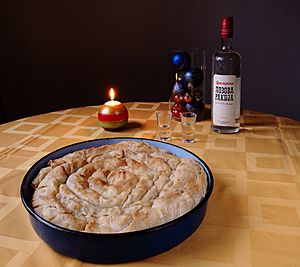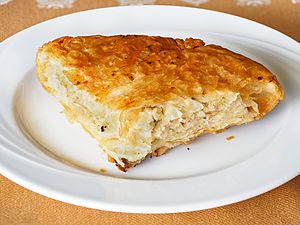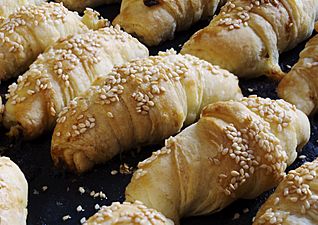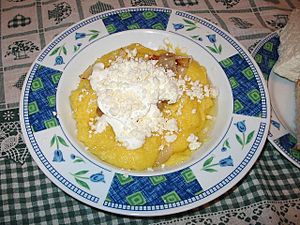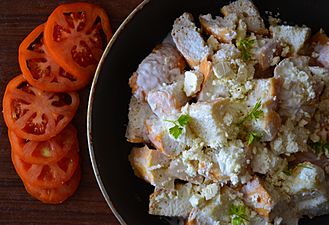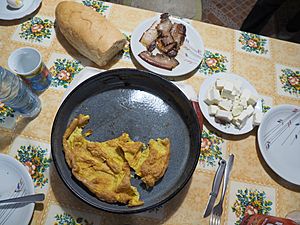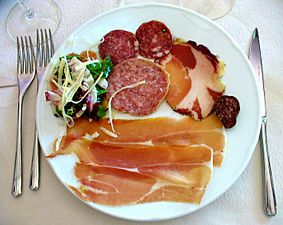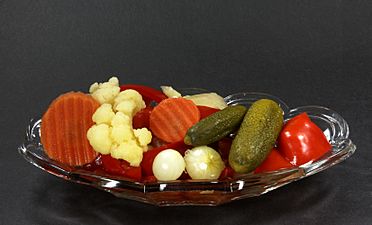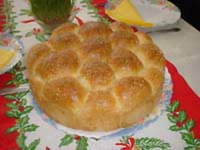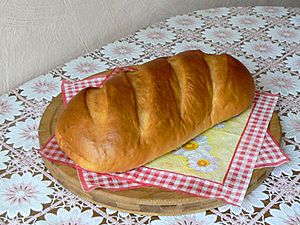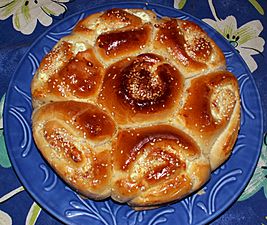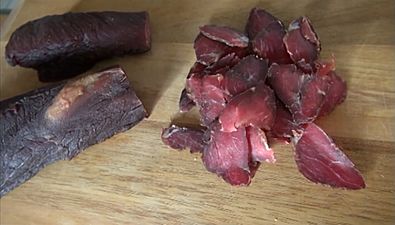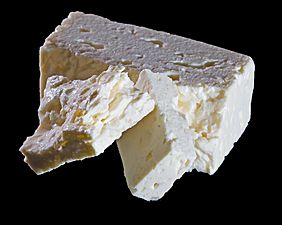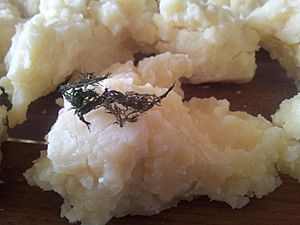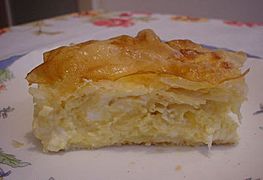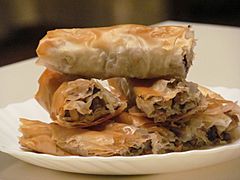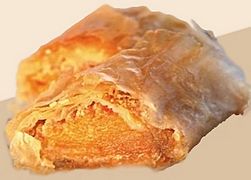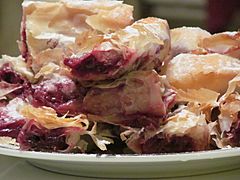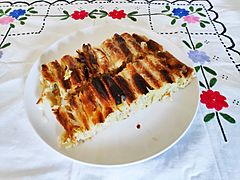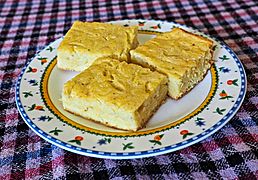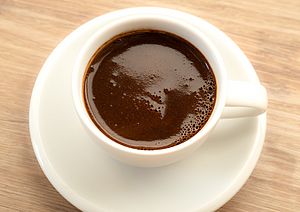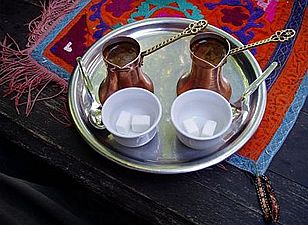Serbian cuisine facts for kids
Serbian cuisine (Serbian: српска кухиња / srpska kuhinja) is the traditional food of Serbia. It's a mix of different cooking styles from the Balkans, Eastern Europe, and even some Central European influences. For hundreds of years, Serbia has been a crossroads between East and West, so its food has picked up flavors and ideas from places like Greece, the Byzantine Empire, and the Ottoman Empire.
Serbian food is known for being hearty and full of flavor. It uses fresh, high-quality ingredients. You'll find lots of tasty meats, vegetables, breads, cheeses, and delicious pastries and desserts. People in Serbia often make many foods at home that others might buy from a store, like fruit brandies (rakija), jams, and pickled vegetables. Cooking is a big part of family life and traditions in Serbia.
The Serbian government has laws against making or bringing in genetically modified foods. This decision is good for the environment, but it has caused some disagreements with the World Trade Organization.
Contents
Overview of Serbian Food
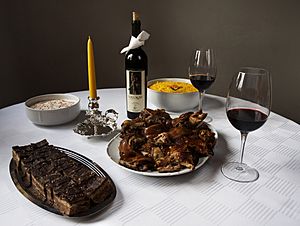
Some of Serbia's most famous dishes include sarma (meat and rice rolled in cabbage leaves), gibanica (a cheesy egg pie), pljeskavica (a grilled meat patty), and ćevapi (grilled meat rolls). The national drink is rakija, which is a fruit brandy.
Serbian food has a mild, fresh, and natural taste. Common seasonings are salt, black pepper, and paprika. Because fresh ingredients are so important, many dishes are eaten only at certain times of the year.
Most Serbians eat three meals a day: breakfast, lunch, and dinner. Lunch is usually the biggest meal. Long ago, people only ate lunch and dinner, but breakfast became popular in the late 1800s.
History of Serbian Cuisine
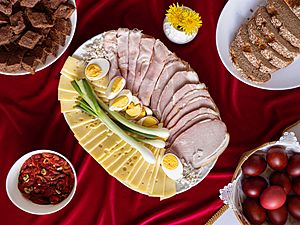
Long ago, in 1179, a visitor named William of Tyre described the Serbs as being "rich in herds and flocks." He said they had plenty of milk, cheese, butter, meat, honey, and wax. This shows that dairy and meat have been important parts of their diet for a very long time.
The first Serbian cookbook was called The Big Serbian Cookbook, written by Katarina Popović-Midzina in 1877. Another very famous one is Pata's Cookbook, written by Spasenija Pata Marković in 1907, which is still printed today!
An old legend says that during the 14th-century Serbian Empire, people in the palace ate with golden spoons and forks. Historians believe that in medieval Serbia, people mainly ate milk, dairy products, fruits, and vegetables. They didn't eat much bread, but when they did, rich people had wheat bread, and poor people ate bread made from oats and rye. Wild game was the main meat, as cattle were kept for farm work.
Meals in Serbia
Breakfast
Breakfast in Serbia is an early and filling meal. It's packed with energy to help you start your day. People often eat bread with butter, jam, yogurt, or cheese. They might also have bacon, sausage, eggs, or kajmak (a creamy dairy product).
Many Serbians grab fresh pastries from a bakery in the morning. These include pogačice, paštete, kifle (which can be sweet or salty), and burek (a savory pastry often filled with meat or cheese). Other popular breakfast foods are kačamak (a type of polenta) and proja (cornbread). Before breakfast, many people enjoy a cup of kava (Turkish coffee) or espresso. With breakfast, they might drink tea, milk, or chocolate milk.
Appetizers
Meze is a plate of small dishes and appetizers. In Serbia, it usually has slices of cured meats, sausages, cheeses, olives, and fresh vegetables. It's often served with drinks or as a starter before a bigger meal.
-
Meze (assorted appetizers)
-
Zimnica (pickled vegetables)
-
Meze (another view)
-
Zimnica (more pickled vegetables)
-
Meze (Serbian appetizer)
Soups
Soups are eaten as a first course at almost every lunch in Serbia. They are thought to be very good for your health. There are two main types: thin soups called supa, and thicker soups called čorba that often have a special thickening mix or eggs. The most common soups are simple stews made with beef, chicken, or lamb, often with noodles. Lamb, veal, and fish soups are considered special treats.
| Type | Image | Serbian Cyrillic | Serbian Latin | What it is |
|---|---|---|---|---|
| Consommé |  |
Домаћа супа | Domaća supa | A simple chicken or beef soup with noodles or dumplings. Very common in home cooking. |
| Lamb soup |  |
Јагњећа чорба | Jagnjeća čorba | A delicious soup made with lamb. |
| Fisherman's soup |  |
Рибља чорба | Riblja čorba | A spicy fish soup, popular in the Panonian region. |
| Tomato soup |  |
Парадајз чорба | Paradajz čorba | A warm and comforting soup made from tomatoes. |
Main Course
The main course is usually a meat dish. Besides barbecue (roštilj), people often cook by braising (cooking slowly in liquid), stewing, or roasting in an oven.
| Type | Image | Serbian Cyrillic | Serbian Latin | What it is |
|---|---|---|---|---|
| Rotisserie | Печење | Pečenje | A whole pig or lamb roasted slowly on a spit over a fire. | |
| Đuveč |  |
Ђувеч | Đuveč | A vegetable dish similar to ratatouille, cooked as a stew or baked in a casserole. |
| Karađorđeva šnicla |  |
Карађорђева шницла | Karađorđeva šnicla | A breaded steak rolled and stuffed with kajmak, ham, and cheese. |
| Moussaka |  |
Мусака | Musaka | A casserole with minced meat and potatoes, zucchini, or eggplant. |
| Mućkalica |  |
Мућкалица | Mućkalica | A spicy stew made with pork, tomatoes, and peppers, popular in southern Serbia. |
| Goulash |  |
Гулаш | Gulaš | A meat and vegetable stew seasoned with paprika, popular across Central Europe and the Balkans. |
| Podvarak |  |
Подварак | Podvarak | A casserole of fresh cabbage with grape vinegar, often with meat and other vegetables. |
| Prebranac |  |
Пребранац | Prebranac | A baked bean casserole. |
| Sarma |  |
Сарма | Sarma | Cabbage, chard, or vine leaves stuffed with rice and minced meat. |
| Sataraš |  |
Сатараш | Sataraš | A dish made with bell peppers, tomatoes, and onions. |
| Beans |  |
Пасуљ | Pasulj | A hearty bean stew. |
| Stuffed peppers |  |
Пуњене паприке | Punjene paprike | Peppers filled with rice and minced meat. |
| Stuffed zucchini |  |
Пуњене тиквице | Punjene tikvice | Zucchini filled with rice and minced meat. |
| Green beans |  |
Боранија | Boranija | A green bean stew. |
Roštilj (Barbecue)
Grilling is super popular in Serbia! Grilled meats are often the main dishes in restaurants. They are usually served together on big plates. You can also find them as fast food. The cities of Leskovac and Novi Pazar are especially famous for their barbecue.
| Type | Image | Serbian Cyrillic | Serbian Latin | What it is |
|---|---|---|---|---|
| Pljeskavica |  |
Пљескавица | Pljeskavica | A grilled patty made from ground pork or beef; this is a National Dish. |
| Ćevapi |  |
Ћевапи (ћевапи) | Ćevapčići (ćevapi) | Grilled sticks of ground pork or beef; also a National Dish. |
| Pork loin | Вешалица | Vešalica | Grilled strips of pork loin. | |
| Skewers | Ражњићи | Ražnjići | Chunks of meat and vegetables grilled on skewers. |
Bread
Bread is a very important part of Serbian meals. It's often used in special traditions. For example, a traditional Serbian welcome is to offer guests bread and salt. Bread also plays a big role in religious ceremonies. Many Serbs believe it's wrong to throw away bread, no matter how old it is. Even though foods like pasta, rice, and potatoes are now common, many Serbs still eat bread with their meals.
Most bakeries sell white wheat bread loaves. Recently, black bread and different types of graham bread have become popular again. In many country homes, bread is still baked in cast iron ovens, often in larger loaves.
-
Đevrek (a type of bread ring)
-
Soda bread (a traditional round bread)
-
Bread loaf
-
Pogača (a soft, round bread)
Salads
In Serbia, salads are usually eaten as a side dish with the main meal. Simple salads are made with sliced lettuce, cabbage, tomato, cucumber, or carrot, often with olives, oil, vinegar, salt, and spices.
| Type | Image | Serbian Cyrillic | Serbian Latin | What it is |
|---|---|---|---|---|
| Serbian salad | Српска салата | Srpska salata | Diced tomatoes, cucumbers, and onions with a simple dressing of oil and vinegar. | |
| Shopska salad |  |
Шопска салата | Šopska salata | Similar to Serbian salad, but with white cheese on top. |
| Greek salad |  |
Грчка салата | Grčka salata | Diced tomatoes, cucumbers, and onions, topped with olives and feta cheese, dressed with olive oil. Popular in Serbia, though it's from Greece. |
| Cabbage salad |  |
Купус салата | Kupus salata | Shredded cabbage with a vinegar dressing. |
| Zimnica |  |
Зимница | Zimnica | Various pickled vegetables. |
| Russian salad |  |
Руска салата | Ruska salata | Diced boiled potatoes, carrots, pickles, green peas, eggs, and ham, mixed with mayonnaise. |
Relishes
Relishes are flavorful sauces or spreads that add taste to meals.
| Tomato sauce |  |
Урнебес | Urnebes | Made from minced tomatoes and spices. |
| Ajvar |  |
Ајвар | Ajvar | A popular spread made from red bell peppers. It can be mild or spicy. |
| Ljutenica |  |
Љутеница | Ljutenica | A spicy relish with peppers, carrots, eggplant, onion, garlic, and tomatoes. It's spicier than ajvar. |
| Pinđur |  |
Пинђур | Pinđur | Similar to ajvar but usually made with eggplant. |
Dairy Products
Dairy products are a big part of the Serbian diet. Fermented products like sour milk, kajmak (a creamy cheese spread), yogurt, and pavlaka (sour cream) are common breakfast foods and eaten daily. White cheeses, called sir, are much more common than yellow cheeses. There are many kinds of white cheeses, and some have even won awards for their quality. Serbia also makes Pule cheese from donkey milk, which is known as the most expensive cheese in the world!
Meat Products
Traditional Serbian meat products include simple ham, bacon, dry ribs, and a type of pork rinds called čvarci. These are often made in autumn or early winter when pigs are prepared, and the meat is preserved for the colder months. Cured meats, bacon, and sausages like krvavica (blood sausage) and kulen are also produced. Even less expensive cuts of meat are used to make products like švargla (head cheese).
Some famous Serbian meat products, especially those with special protected status, are:
- Smoked ham (šunka) like užička pršuta from Užice.
- Čvarci, which are pork rinds, including duvan čvarci from Valjevo.
- Various kinds of sausages like sremska domaća kobasica from Srem.
Pies
Pies are very popular in Serbia and can be eaten for breakfast, dinner, or as a snack. They are usually made with thin layers of phyllo dough. There are many ways to make them and lots of different fillings, both sweet and savory. Serbian pies are often named after how they are made or what they are filled with.
One type of pie, štrudla, is not made with phyllo dough but is more like a nut roll.
| ↓ Filling | Form → | Ruffled phyllo | Rolled phyllo | Layered phyllo | Rolled dough |
| ↓ Serbian name → | Бурек | Савијача | Штрудла | ||
| white cheese | Пита са сиром/Сирница | ||||
| white cheese and eggs | Гибаница | Gibanica | |||
| meat | Пита с месом | ||||
| potatoes | Пита с кромпиром/Кромпируша | ||||
| spinach, greens | Пита са зељем/Зељаница | ||||
| sour cherries | Пита са вишњама | ||||
| apples | Пита с јабукама | ||||
| pumpkin | Пита с бундевом/Бундевара | ||||
| walnuts | Штрудла са орасима/Орасница | Česnica (in Vojvodina) |
-
Gibanica (cheese and egg pie)
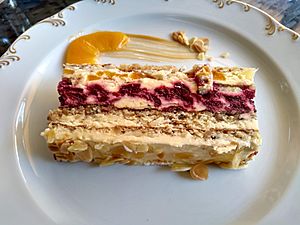
Sweets and Desserts
Sweets are served at the end of meals in Serbia. You'll find a mix of Middle Eastern and European desserts, plus some unique Serbian ones. Besides the ones listed here, pies with sweet fruit fillings are also common.
| Type | Image | Serbian Cyrillic | Serbian Latin | What it is |
|---|---|---|---|---|
| Plazma cake |  |
Плазма торта | Plazma torta | A cake made with crushed Plazma biscuits. |
| Vasa's cake |  |
Васина торта | Vasina torta | A walnut and chocolate cake, one of Serbia's most loved desserts. |
| Dobos cake |  |
Добош торта | Doboš torta | A five-layer sponge cake with chocolate buttercream and a thin caramel top. |
| Reforma cake |  |
Реформа торта | Reforma torta | A layered cake with a rich chocolate butter-cream filling. |
| Slatko |  |
Слатко | Slatko | A fruit preserve served as a sweet treat. |
| Ratluk |  |
Ратлук | Ratluk | A chewy, sweet candy, also known as Turkish delight. |
| Halva |  |
Алва | Alva | A dense sweet treat made from flour or nuts. |
| Baklava |  |
Баклава | Baklava | Sweet pastry with layers of phyllo dough, chopped nuts, and syrup or honey. |
| Tulumbe |  |
Тулумбе | Tulumbe | Fried dough soaked in sweet syrup. |
| Tufahije | 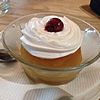 |
Туфахије | Tufahije | Apples stuffed with walnuts and cooked in sugar water. |
| Knedle |  |
Кнедле са шљивама | Knedle sa šljivama | Boiled potato-dough dumplings filled with plums. |
| Krofne |  |
Крофне | Krofne | Light doughnuts filled with chocolate or jam. |
| Krempita |  |
Кремпита | Krempita | A creamy cake dessert with custard and whipped cream. |
| Palačinke |  |
Палачинке | Palačinke | Thin pancakes, similar to crêpes. |
| Vanilla cookies |  |
Ванилице | Vanilice | Small, delicate vanilla cookies. |
| Uštipci |  |
Уштипци | Uštipci | Doughnut-like fried dough balls. |
Ritual Food
Some foods are made for special traditions and celebrations.
| Type | Image | Serbian Cyrillic | Serbian Latin | Occasion | What it is |
|---|---|---|---|---|---|
| Česnica |  |
Чесница | Česnica | Christmas | A special bread with a coin hidden inside. Family members break off pieces, and whoever finds the coin is said to have good luck for the year! |
| Koljivo |  |
Кољиво | Koljivo | Slava | Boiled wheat with almonds or walnuts, eaten during the slava (a family's patron saint day). |
| Slavski kolač |  |
Славски колач | Slavski kolač | Slava | A special ceremonial bread for the slava celebration. |
Drinks
Non-alcoholic Drinks
Domestic coffee (also called Serbian coffee) is the most popular non-alcoholic drink in Serbia. People usually make it at home and enjoy it with friends or family. Sometimes, slatko (fruit preserve) or ratluk (Turkish delight) are served with coffee. Most Serbians start their day with a cup of coffee. Herbal teas are usually drunk for health reasons, like when you're not feeling well. Yogurt and kefir are also common dairy drinks, often enjoyed with savory pastries. A drink made from corn, called boza, used to be popular but is rarely seen today.
Serbia also produces many local fruit juices and mineral water brands. The Knjaz Miloš mineral water is considered a national favorite.
Alcoholic Drinks
Rakija
Rakija is a general name for strong drinks made from fruits. There are many types, usually named after the fruit they are made from, like plum rakija or grape rakija. Many people in Serbia make their own rakija at home. Loza, made from grapes, is considered the national drink.
Beer
Beer has become very popular in Serbia recently, even more so than traditional rakija and wine. The biggest brewery in Serbia is Apatinska pivara.
Wine
Serbia has nearly 110,000 hectares (about 270,000 acres) of vineyards, producing around 645,000 tons of grapes each year. Southern Serbia produces the most wine. Because of this, Serbia is known around the world as a great wine producer.
-
Boza (a traditional fermented drink)
See also
 In Spanish: Gastronomía de Serbia para niños
In Spanish: Gastronomía de Serbia para niños


